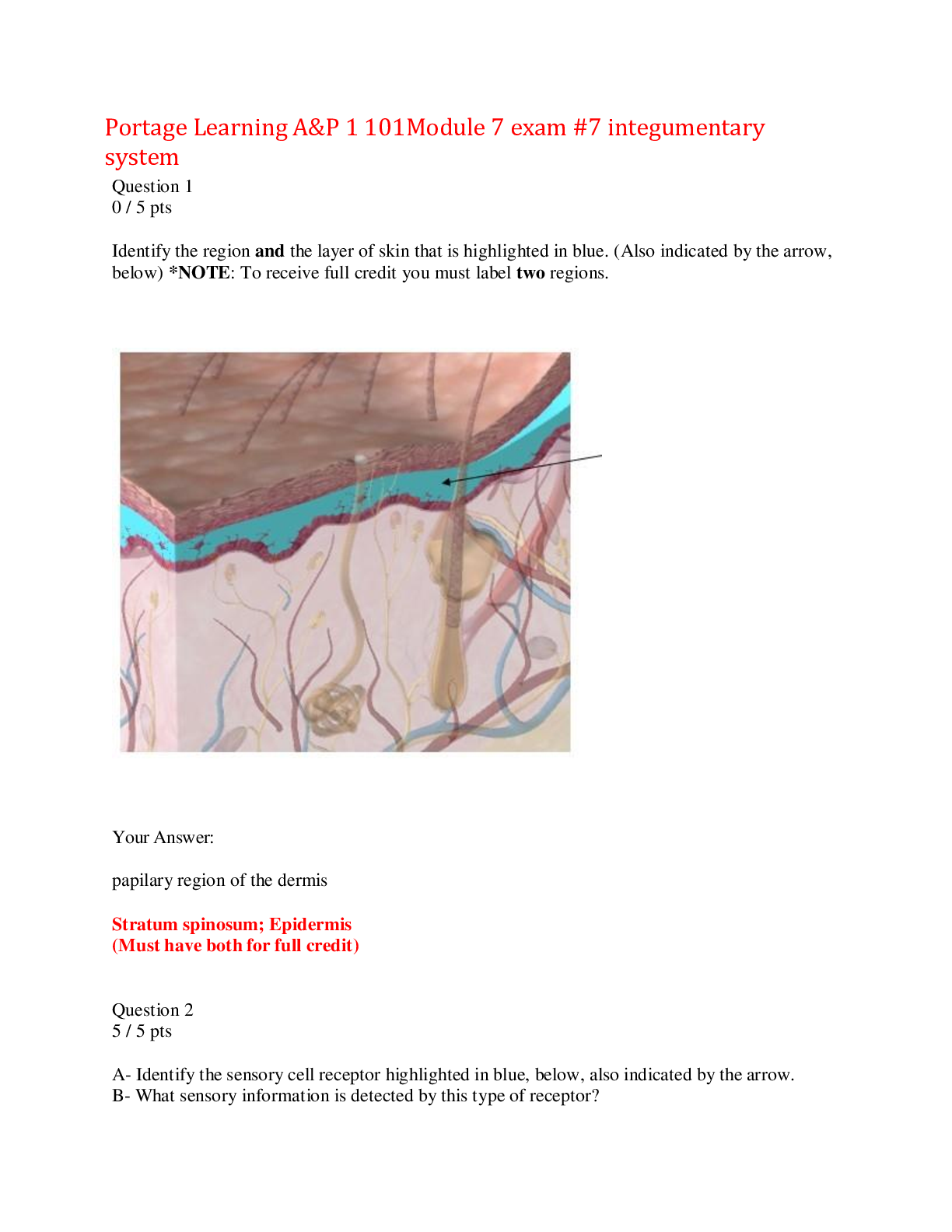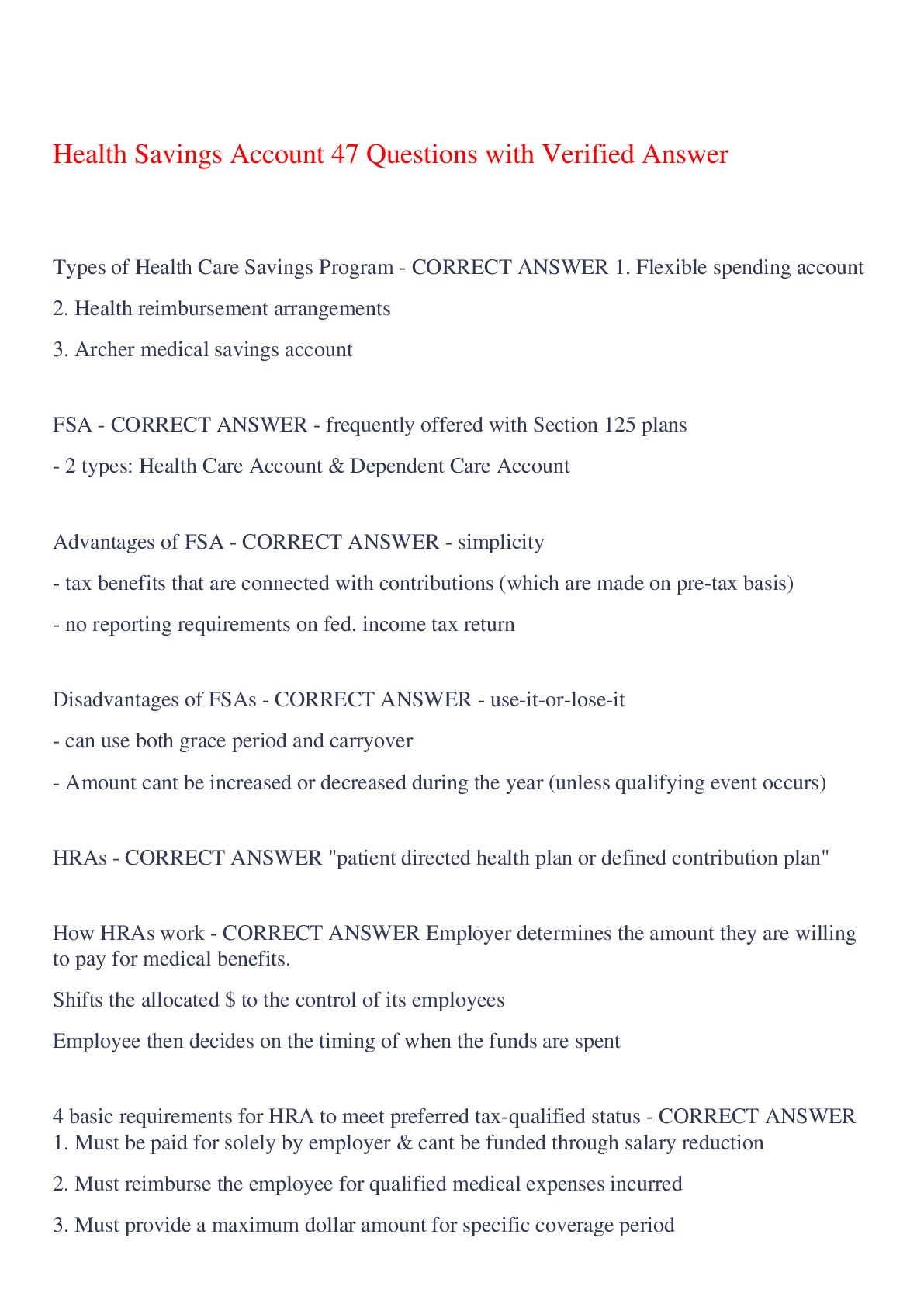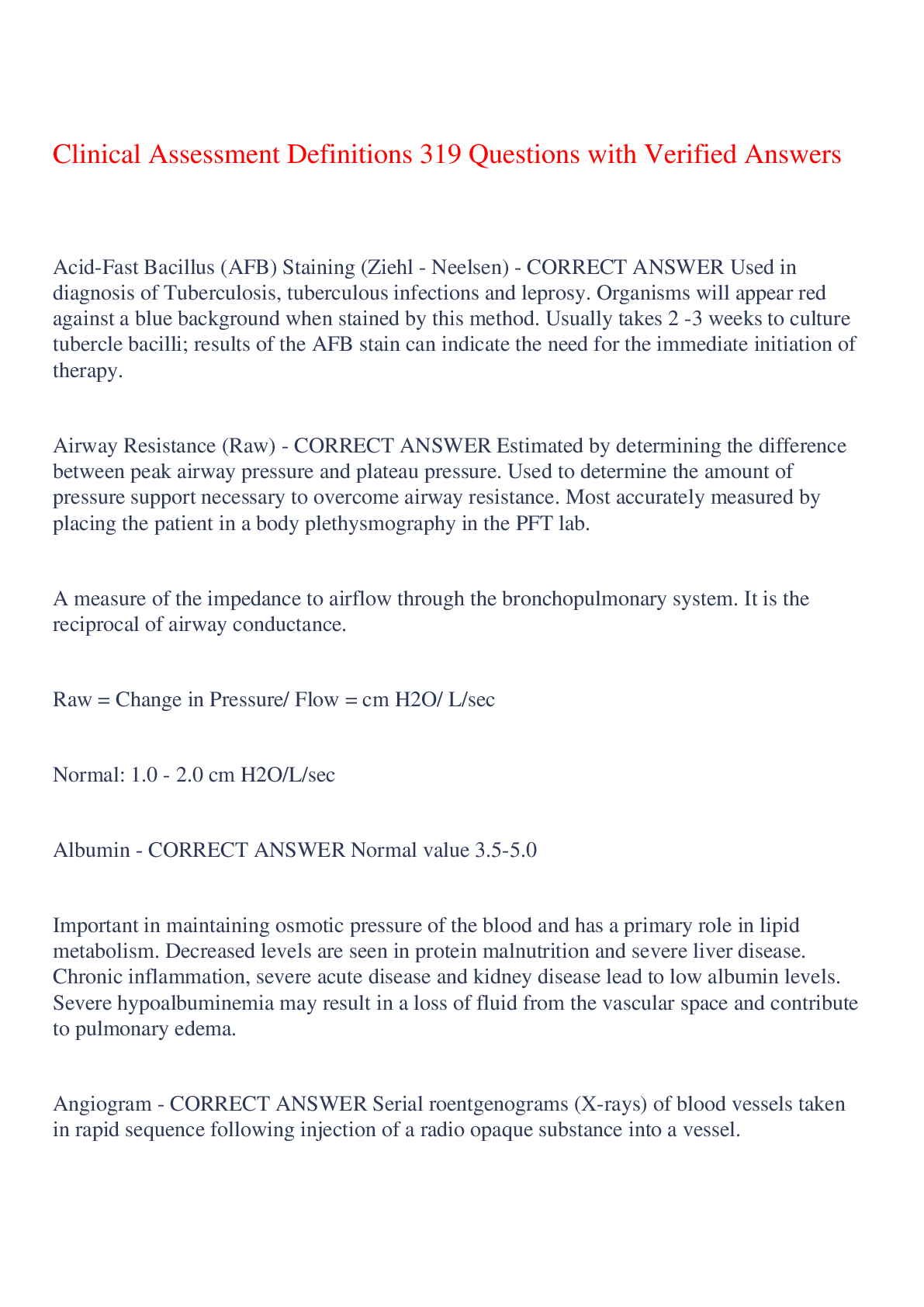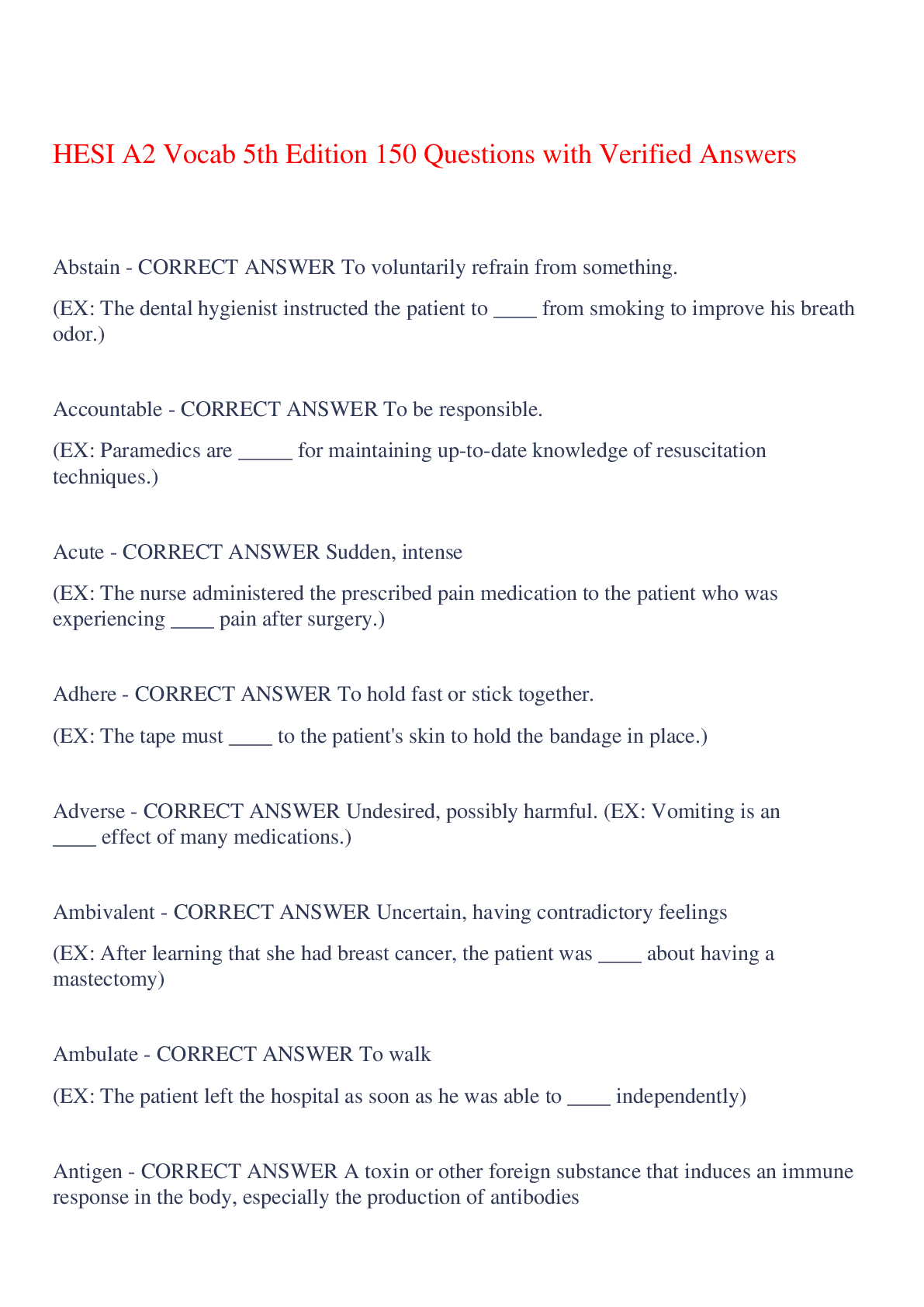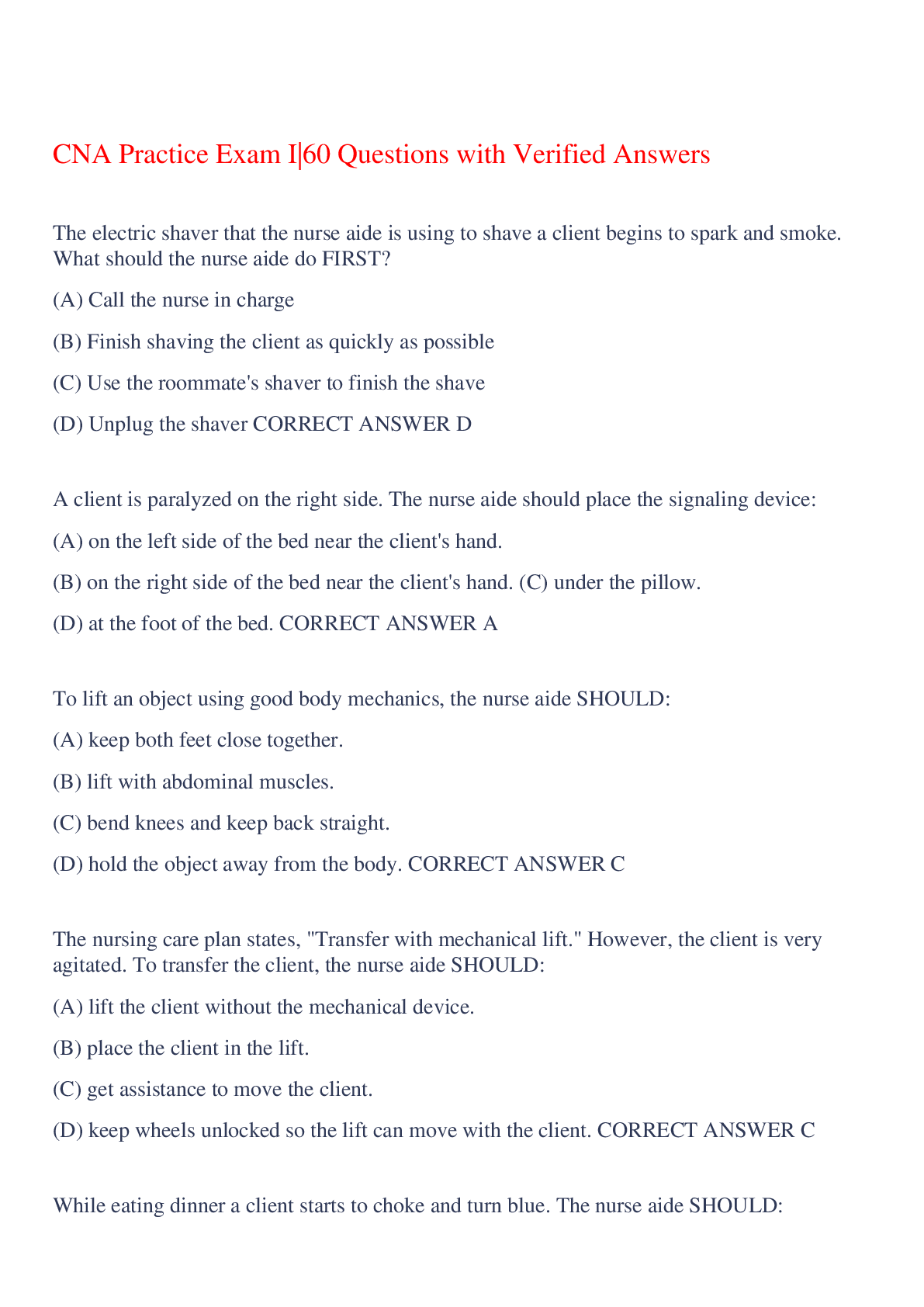NNCC CCHT practice 30 Questions with Verified Answers,100% CORRECT
Document Content and Description Below
NNCC CCHT practice 30 Questions with Verified Answers Peritoneal dialysis differs from hemodialysis in which of the following ways? A. PD requires both vascular access and abdominal access. B. ... PD cannot be done at home C. PD access is by an intra-abdominal catheter D. Sterile dialysate is not require for PD - CORRECT ANSWER C The main difference between an arteriovenous shunt (AVS) and an arteriovenous fistula (AVF) is: A. AVS is entirely within the arm B. AVF is entirely within the arm C. AVF is more likely to become clotted or infected D. AVF requires an external tube - CORRECT ANSWER B Which of the following dialyzers is used currently? a. Kiil B. flat plate c. coil d. hollow tube - CORRECT ANSWER D Which of the following kidney structures connects with and delivers urine directly to the ureter? a. pelvis b, calyx c, glomerulus d. cortex - CORRECT ANSWER A The glomerular filtration rate is an important index of renal function and in the normal adult is approximately: a. 50 ml/nib/1.73 m2 b. 75 ml/min/1.73 m 2 c. 125 mL/min/1,73m2 d. 200 ml/ min/ 1.73m2 - CORRECT ANSWER C All of the following substances are produced by the kidney EXCEPT: a. renin b. aldosterone c. erythropoietin d. calcitriol - CORRECT ANSWER B The most likely cause of post-renal failure is: A. severe dehydration B. nephrotoxic drug C. glomerulonephritis D. benign prostatic hypertrophy - CORRECT ANSWER D The most common cause of chronic kidney disease in the United States is: a. diabetes b. hypertension c. glomerulonephritis d. polycystic kidney disease - CORRECT ANSWER A Uremia may cause which of the following conditions? a. itching b. edema (swelling) of extremities c. anemia d. all of the above - CORRECT ANSWER D All of the following conditions are associated with chronic kidney failure except: a. low hemoglobin b. hypoparathyroidism c. hyperkalemia d. hyperphosphatemia - CORRECT ANSWER B What percentage of transplanted kidneys is functional 1 year after transplantation? a. 90% b. 70% c. 50% d. 30% - CORRECT ANSWER A Which hemodialysis schedule is likely to be most efficient? a. in-center hemodialysis 3-4 hour sessions, 3 days a week b. conventional home dialysis c. short daily home hemodialysis, 2-3 hour sessions, 5-7 days a week d. nocturnal home hemodialysis, 8 hours during sleep, 3 days a week - CORRECT ANSWER C The fluid restriction for most patients undergoing in-center hemodialysis is equal to urine volume/day plus: a. 0 L b. 0.5 L c. 1L d 2 L. - CORRECT ANSWER C Failure to excrete beta20microglobulin in patients with kidney failure predisposes to: a. pericarditis b. amyloidosis c. neuropathy d. seizures - CORRECT ANSWER B Blood tests for ferritin are performed in hemodialysis patients: a. to check for iron stores b. to check for magnesium levels c. as an alternative to hemoglobin concentration d. to maintain electrolyte balance - CORRECT ANSWER A Which of the following phosphate binders would best control hyperphosphatemia with the fewest side effects in patients with end stage kidney disease? a. aluminum hydroxide b. calcium carbonate c. high diary product diet d. lanthanum carbonate - CORRECT ANSWER D Hemodialysis patients should be taught to: a. put in their own needles b. weigh themselves and record it c. check their dialyzer settings and dialysate d. do all of the above - CORRECT ANSWER D All of the following statements about vitamins in dialysis patients are true EXCEPT: a. dialysis does not remove water-soluble vitamins b. supplemental b- complex vitamins should be given c. vitamin d should be given to most dialysis patients d. megadose fat- or water soluble vitamins should not be given - CORRECT ANSWER A Osmosis is best defined as: a. diffusion of solute in semipermeable from high to low b. diffusion of solvent in semipermeable from low to high c. a verision of hydraulic pressure used in dialysis d. diffusion of solvent through semipermeable from high to low solute - CORRECT ANSWER B In hemodialysis, blood and sialysate have which of the following properties? a. They flow in the same direction b. they flow in opposite directions c. they mix within the dialyzer d. they do not require a semipermeable membrane - CORRECT ANSWER B In the dialyzer water may be removed from a. the intracellular compartment b. the intravascular compartment c. the interstitial compartment d. all of the above - CORRECT ANSWER B Which site in the hemodialysis pathway has the highest positive pressure? a. arterial blood in the afferent tubing b. blood entering the dialyzer fibers c. blood leaving the dialyzer fibers d. blood in the venous return - CORRECT ANSWER B The term "sieving coefficient of a membrane" refers to the: a. fraction of solute that passes through the membrane by convection b. amount of water required for solute drag through the membrane c. concentration of pores in the membrane d. size of the pores in the membrane - CORRECT ANSWER A Water moves from one body compartment to another by: a. ultrafiltration b. active transport c. osmotic forces d. all of the above - CORRECT ANSWER C Biocompatibility is best illustrated by: a. synthetic membranes that do not absorb blood proteins as well as cellulose membranes b. independence from protein absorption of the membrane c. reprocessed dialyzers that have a lower biocompatibility than new ones d. reprocessed dialyzers that have a better biocompatibility than new ones - CORRECT ANSWER D The amount of fluid to be taken from the patient during hemodialysis: a. is independent of the filtration pressure b. requires the dialysate to have a higher pressure than the blood c. may be calculated by subtracting the patients estimated dry weight from the predialysis weight and adding any fluid d. may be calculated by adding the patient's predialysis weight - CORRECT ANSWER C The ultrafiltration coefficient of a dialyzer refers to the: a. fluid passes through the membrane in 1 hour b. pressure in the blood compartment needed to force fluid through the membrane c. pressure difference across the membrane d. fluid that passes through the membrane in 1 min - CORRECT ANSWER A The molecular weight cutoff of a dialyzer is 12,000 daltons. Which of the following molecules would not pass through the membrane into the dialysate? a. phosphate b. urea c. albumin d. sodium - CORRECT ANSWER C Clearance of low-molecular-weight molecules by dialysis is accomplished mostly by: a. convection b. diffusion c. absorption d. solvent drag - CORRECT ANSWER B A hollow fiber dialyzer has which of the following properties? a. very fine fiber tubes held in place b. fibers about 1 cm in width c. a high membrane compliance d. a high resistance in the fibers, enhancing UF pressure - CORRECT ANSWER A [Show More]
Last updated: 8 months ago
Preview 1 out of 7 pages

Reviews( 0 )
Document information
Connected school, study & course
About the document
Uploaded On
Aug 27, 2023
Number of pages
7
Written in
Additional information
This document has been written for:
Uploaded
Aug 27, 2023
Downloads
0
Views
62






